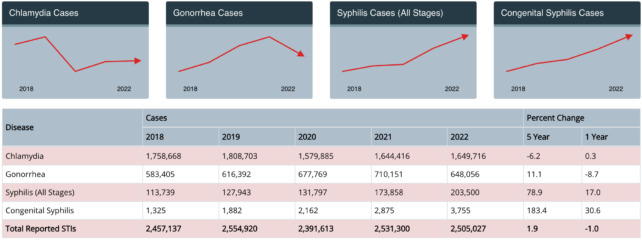ARTICLE AD
 Syphilis bacteria. (CHRISTOPH BURGSTEDT/SCIENCE PHOTO LIBRARY/Getty Images)
Syphilis bacteria. (CHRISTOPH BURGSTEDT/SCIENCE PHOTO LIBRARY/Getty Images)
The US is dealing with an "out-of-control" epidemic of sexually transmitted infections, according to the National Coalition of STD Directors.
The warning, issued in January, followed the release of an annual data report on STIs by the US Centers for Disease Control and Prevention (CDC).
The exasperation of public health officials can be felt in the very first sentence of the online announcement.
"Yet again," the CDC website said, "more than 2.5 million cases of chlamydia, gonorrhea, and syphilis were reported in the United States."
 Trends in annual reported STI cases from 2018 to 2022. (CDC)
Trends in annual reported STI cases from 2018 to 2022. (CDC)The most common STI in the US in 2022 was chlamydia, which has remained in the top spot for years now. Nevertheless, it is the recent rise in syphilis that is concerning health officials most.
According to CDC data, syphilis cases of all stages have increased by 80 percent in the past five years.
While most think of adults contracting STIs, syphilis threatens the lives of babies, too. When a child contracts syphilis from the mother during pregnancy or birth, it is known as congenital syphilis.
In 2022, more than 3,700 of these cases were officially reported in the US. That's a 937 percent increase in a single decade.
The good news is that syphilis is curable with the right antibiotics. The bad news is that until the infection is diagnosed and treated, it can cause irreversible damage to the body. In babies, syphilis is particularly dangerous, sometimes causing developmental delays, seizures, or even death.
In adults, syphilis is spread via vaginal, anal, or oral sex, and it tends to progress in stages. The primary stage usually involves sores around the mouth or genitals, while the secondary stage can trigger rashes on the body and flu-like symptoms, including fever, headache, sore throat, and fatigue.
These first two stages are when the infection is most contagious. Rarely does the disease progress to the third stage, which can impact the organs and prove fatal.
The fact that early stages of syphilis are increasing by roughly 10 percent a year is highly concerning, and threatens the health of babies nationwide.
In just a single year, congenital syphilis cases have increased by 31 percent in the US. Black or African American children were disproportionately affected.
While nearly every single state reported a case of congenital syphilis in 2022, the states of Texas, California, Arizona, Florida, and Louisiana represented 57 percent of all reports.
"Tragically," wrote Laura Bachmann, the CDC Director for STD Prevention, "these infections resulted in 282 stillbirths and infant deaths in 2022."
Such dire outcomes are hardly inevitable. Timely syphilis testing and treatment during pregnancy could have prevented 88 percent of these cases, experts say.
So why isn't that happening?
"The STI field has reached a tipping point," Bachmann explained.
"We have long known that these infections are common, but we have not faced such severe effects of syphilis in decades. Recent public health emergencies diverted program resources and threatened the health of those already disproportionately affected by STIs. We must move now to pick up the pieces."
Officials at the CDC are calling for "swift innovation and collaboration" from all public health experts who play a role in STI prevention.
Their voices are already being joined by numerous health associations, including the National Association of County and City Health Officials (NACCHO), the American Sexual Health Association, the American Academy of Family Physicians, and the National Coalition of STD Directors (NCSDDC).
"The CDC's latest STI data shows that our nation is facing a rapidly deteriorating public health crisis with real lives at stake," a statement from the NCSDDC warned.
"STIs – especially syphilis – will continue to spiral out of control until the administration and Congress provide communities with the funding they need to provide the most basic screening, treatment, and prevention services."
While President Biden has put together a multi-agency plan to address America's rising STI cases, funding for the endeavor remains uncertain.
Despite the escalating situation, in March the NCSDDC confirmed the White House's 2025 budget blueprint shows no increase in federal STI funding for the CDC.
An earlier version of this article was published in February 2024.

 7 months ago
70
7 months ago
70 

